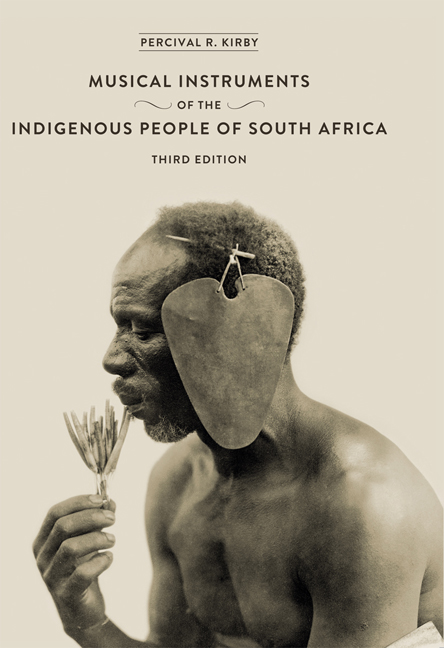Book contents
- Frontmatter
- Dedication
- Map
- Contents
- Foreword
- Preface to First Edition
- Preface to Second Edition
- Acknowledgements
- Acknowledgements to Third Edition
- List of Illustrations
- 1 Rattles and Clappers
- 2 Drums
- 3 Xylophones and ‘Sansas’
- 4 Bull-Roarers and Spinning-Disks
- 5 Horns and Trumpets
- 6 Whistles, Flutes, and Vibrating Reeds
- 7 Reed-Flute Ensembles
- 8 The ‘Gora’, A Stringed-Wind Instrument
- 9 Stringed Instruments
- 10 Bushman and Hottentot Violins and The ‘Ramkie’
- 11 Some European Instruments Played By Natives
- Appendix
- Addenda
- Index
Preface to Second Edition
Published online by Cambridge University Press: 21 April 2018
- Frontmatter
- Dedication
- Map
- Contents
- Foreword
- Preface to First Edition
- Preface to Second Edition
- Acknowledgements
- Acknowledgements to Third Edition
- List of Illustrations
- 1 Rattles and Clappers
- 2 Drums
- 3 Xylophones and ‘Sansas’
- 4 Bull-Roarers and Spinning-Disks
- 5 Horns and Trumpets
- 6 Whistles, Flutes, and Vibrating Reeds
- 7 Reed-Flute Ensembles
- 8 The ‘Gora’, A Stringed-Wind Instrument
- 9 Stringed Instruments
- 10 Bushman and Hottentot Violins and The ‘Ramkie’
- 11 Some European Instruments Played By Natives
- Appendix
- Addenda
- Index
Summary
WHILE writing this book, the original edition of which was published in 1934, I found it necessary to make several very important decisions regarding it.
In the first place I had to decide whether to arrange my material tribally, or to deal with each type of musical instrument separately from the technological and historical points of view, allowing the tribal aspects to emerge incidentally. I chose the second of these alternatives, my chief reason for doing so being that I wished the work to be, as far as was possible, a complete and comparative study of one particular aspect of the life of our aborigines.
In the second place I had to determine what was the most suitable manner of classifying the various musical instruments. I was, of course, well aware that no universally accepted ‘taxonomy’ of musical instruments existed, though two excellent systems had been evolved in recent years.
But these systems, respectively devised by Gevaert and Mahillon of Brussels (1877) and by Hornbostel and Sachs of Berlin (1914), although eminently scientific, ‘seemed to belong’, as my friend the late Canon Francis W. Galpin put it, ‘rather to natural science than to human artifacts’. For this reason I preferred to retain the age-old simple classification of musical instruments into the three main groups of percussion, wind, and string.
But for the use of those who may wish to relate the instruments described in the present volume to the more scientific system of classification, I quote here the five main ‘Divisions’ as set out by Canon Galpin in the simplest possible terms. They are:
Autophonic, or self-vibrating instruments (rattles, xylophones, etc.).
Membranophonic, or skin-vibrating instruments (drums, etc.).
Chordophonic, or string-vibrating instruments (musical bows, etc.).
Aerophonic, or wind-vibrating instruments (whistles, flutes, etc.).
Electrophonic, or electrically vibrating instruments (‘Hammond’ organ, etc.).
It will be seen at once that no musical instrument belonging to Division 5 has ever been made or used by aborigines of South Africa. On the other hand those described in Chapters I and III of this book belong to Division 1, those in Chapter II to Division 2, those in Chapters IV, V, VI, and VII to Division 4, and those in Chapters VIII, IX, and X, to Division 3.
- Type
- Chapter
- Information
- The Musical Instruments of the Indigenous People of South Africa , pp. xix - xxiiPublisher: Wits University PressPrint publication year: 2013



